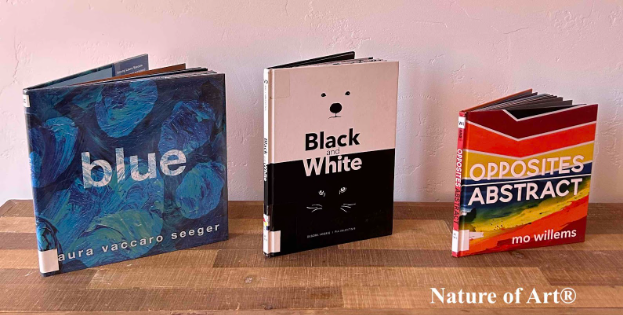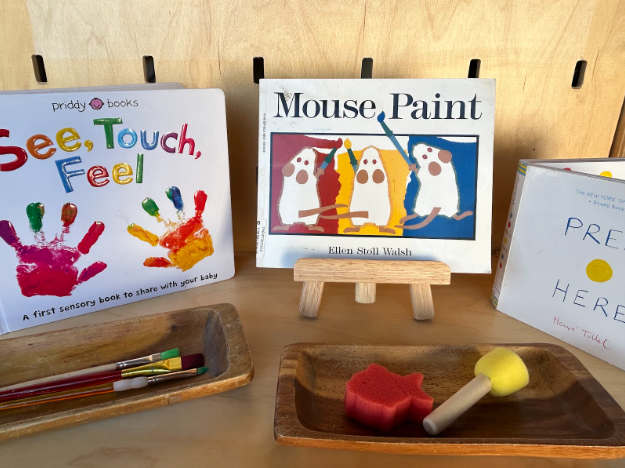
If you’re looking to enhance your art lessons, library books might just be your best-kept secret. Over the years, I’ve discovered an endless well of inspiration through story book. I believe they can transform how parents and teachers approach art education. Let’s talk about why books are so powerful in teaching art literacy. Plus how you can easily incorporate them into your lessons. And I will show you how to use library books to enrich art lessons?
Why Use Books in Art Education?
Books go far beyond storytelling—they’re gateways to exploring art elements. When you use books to teach, you’re not only engaging children with vibrant visuals. But also giving them the tools to understand how art is created and appreciated.
For instance, when you sit down and read storybooks, you can guide your child to observe the artwork. Pointing out the colors, shapes, lines, patterns, and textures. These are the very building blocks of art literacy! After reading, go back to specific pages and use the illustrations as examples. Explain concepts like value, texture, balance, or opposites.
This process reinforces art elements in a natural, meaningful way. It also connects art to real-life storytelling, creating an engaging and memorable experience.

Books Help Children See Art Elements
Books offer a unique way to develop visual perception—the skill of interpreting and making sense of what we see. When children study the designs in illustrations, they start to understand how elements like lines, forms, and spaces come together.
For example, the books Blue by Laura Vaccaro Seeger and Opposites Abstract by Mo Willems are not just fun reads. They teach important visual arts concepts. You can see how artists play with contrasts, symmetry, or even emotions through their use of colors and shapes. Highlighting these art elements builds a deeper understanding of how art “works” and sharpens students’ artistic eye. More on this in my book The Way Children Make Art, where I discuss visual perception in depth and how you can nurture it in your children.
Why the Library Is Your Best Friend
One of the best parts about using books for art lessons? The library.
It’s free! I used to visit the library every week when homeschooling my own kids. Even now, I find myself wandering through its aisles, searching for fresh inspiration for teaching art lessons. The truth is, you don’t need to own an endless supply of books at home. You can borrow beautiful, well-illustrated books for weeks at a time and use them as the centerpiece of your lessons.
Feeling doubtful? Challenge yourself to create an art lesson out of any book in your collection (or even better, your local library’s collection).
Recommended Books
Here are some of my recent favorites, which are perfect for teaching art elements and inspiring creative conversations with kids:
- Blue by Laura Vaccaro Seeger
- Black and White by Deborah Vogrig and Pia Valentinis
- Opposites Abstract by Mo Willems
Each of these books showcases art elements beautifully and can serve as an art lesson on its own. You’ll find a wealth of ideas to play with, whether it’s exploring opposites, understanding abstract, or simply enjoying the world of colors.
Take Your Art Lessons to the Next Level
If you’re ready to dig even deeper into teaching art literacy, I highly recommend checking out my paperback and digital books. They’re packed full of tips, step-by-step guides, and creative exercises to help you build meaningful art lessons.
- Art Guide- Early Childhood
- Montessori Art Guide Early Childhood
- Elementary Art Guide
- Defining Visual Arts
- The Way Children Make Art
Final Thoughts
Using books to teach art elements is an enriching, accessible way to inspire creativity in children. Plus, with the amazing resources available through your local library, creating meaningful art lessons has never been affordable. Start by exploring the books I’ve recommended or head to your library to discover new favorites. With a little guidance and imagination, you can turn any book into a doorway to art literacy.
Looking for a more structured approach or a easy system to follow, grab one (or all!) of my Art Curriculums.
Check one of my video resource:
Using Children’s Story Books to Theme With Art Activities
Happy reading and creating, Spramani
All rights reserved © 2025, Nature of Art®

No part of this blog may be used or be reproduced in any manner whatsoever including reproducing, publishing, performing, and making any adaptions of the work – including translation into another foreign language without written permission except in the case of brief quotations embodied in critical articles and reviews. Nature of Art® Publishing P.O. Box 443 Solana Beach, California 92075.
